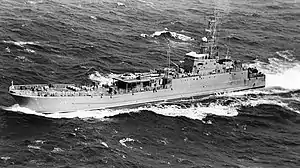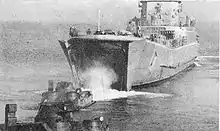 Polnocny-C | |
| Class overview | |
|---|---|
| Name | Polnochny |
| Builders | Stocznia Północna shipyard at Gdańsk, (Poland), Stocznia Marynarki Wojennej at Gdynia, Poland |
| Operators | |
| Succeeded by | |
| Subclasses |
|
| In commission | 1967 |
| Completed | 108 |
| Active | 33 |
| General characteristics | |
| Type | Landing ship, tank |
| Displacement | 834 tons full load (Polnocny-B) |
| Length | 73 m (239 ft 6 in) |
| Beam | 9.6 m (31 ft 6 in) |
| Draught | 2.3 m (7 ft 7 in) |
| Propulsion | 2 Soviet Kolomna 40-D two stroke diesels, 2 shafts, 4,400 bhp |
| Speed | 18 knots (33 km/h) |
| Range | 1,000 nmi (2,000 km) at 18 kn (33 km/h) |
| Capacity | 12 BMP-2 250 tons |
| Troops | 250 |
| Complement | 41 |
| Armament |
|
The Polnocny (or Polnochny)-class ships are amphibious warfare vessels. They were designed in Poland, in cooperation with the Soviet Navy and were built in Poland between 1967 and 2002. They now serve in several different navies, and some have been converted to civilian use. The name comes from the Stocznia Północna shipyard (Northern Shipyard) at Gdańsk, where they were built. 107 were built by 1986 (last 16 by Stocznia Marynarki Wojennej (Naval Shipyard) at Gdynia, Poland). In 2002, one ship of a modernised design NS-722 was built in Gdynia for Yemen.
Characteristics
The Polnocny-class ships are classified as medium landing ships in the Russian Navy, and are loosely equivalent to Western tank landing ships. They are equipped with a bow ramp that allows beach landings. The Polnocny-C version can carry 12 BMP-2 armored personnel carriers, or 4 Main Battle Tanks, or 250 infantrymen with their weapons like 82 mm Mortars and ATGMs, or 250 tons of rations & stores. Unlike their Western counterparts, these ships can provide substantial fire support for landed troops with their onboard multiple rocket launchers. Other armament consists of anti-aircraft guns and short-range surface-to-air missiles.
Variants
The Polnocny class comprises several sub-types that vary in size and capacity:
- Polnocny-A (Project 770) (46 built):
- Displacement: 800 tons full load
- Length: 73 m
- Speed: 19 knots (35 km/h)
- Polnocny-B (Project 771) (36 built):
- Displacement: 834 tons full load
- Length: 73 m
- Speed: 18 knots (33 km/h)
- Polnocny-C (Project 773) (24 built)
- Displacement: 1150 tons full load
- Length: 81.3 m
- Speed: 18 knots (33 km/h)
- Modified Polnocny-C (Project 776) Amphibious Assault Command Ship (1 built - ORP Grunwald)
- Displacement: 1253 tons full load
- Length: 81.3 m
- Speed: 18 knots (33 km/h)
- Polnocny-D (Project 773U) (4 built)
- Displacement: 1233 tons full load
- Length: 81.3 m
- Speed: 16 knots (30 km/h)
- Aircraft facility: One helicopter platform
- NS-722 class (1 built in 2002)
- Displacement: 1,410 tons full load
- Length: 88.7 m
- Speed: 17 knots (31 km/h)
- Aircraft facility: One helicopter platform
Operational service
Built in large quantities, the Polnocny-class ships were once the mainstay of the Soviet amphibious forces, and gave the Soviet naval infantry an effective force projection capability. They were gradually phased out in favour of hovercraft, and few remain active in the Russian Navy.
Current operators
 Angola - 3 ships
Angola - 3 ships Algeria - 1 Polnocny-B
Algeria - 1 Polnocny-B Azerbaijan - 2 Polnocny-A, 2 Polnocny-B
Azerbaijan - 2 Polnocny-A, 2 Polnocny-B Bulgaria - 2 Polnocny-A (1 withdrawn from service, 1 operational [1])
Bulgaria - 2 Polnocny-A (1 withdrawn from service, 1 operational [1]) Egypt - 3 Polnocny-A
Egypt - 3 Polnocny-A India 3 Polnocny-D
India 3 Polnocny-D

Former operators
See also
References
- ↑ "Вимпел". Archived from the original on 10 August 2016. Retrieved 17 September 2014.
- ↑ Wertheim, Eric (2007). The Naval Institute Guide to Combat Fleets of the World. Annapolis: Naval Institute Press. p. 448. ISBN 9781591149552.
- ↑ "Trials of Landing Ship Ibn Haritha". Zagreb: Adria-Mar Shipbuilding Ltd. 2009. Archived from the original on 9 March 2014. Retrieved 9 March 2014.
- ↑ "Libya threatens to bomb North Korea-flagged tanker". BBC News. 8 March 2014. Retrieved 6 July 2019.
- ↑ "Yemen" (PDF). Archived from the original (PDF) on 26 October 2006. Retrieved 12 February 2007.
- ↑ "Marines: August 6, 2002". Strategypage.com. 6 August 2002. Retrieved 3 September 2013.
- ↑ Moore 1974, p. 171
- ↑ "Medium landing ships - Project 770". russianships.info. Retrieved 18 August 2021.
Bibliography
- Moore, Capt. John (1974). Jane's Fighting Ships 1974-75. Jane's Information Group. ISBN 978-0354005067.
- Watts, A.J.(2006); Jane's warship recognition guide; Collins; ISBN 0-06-084992-4
- Jarosław Ciślak; Polska Marynarka Wojenna 1995 (Polish Navy 1995); Lampart, Warsaw 1995; ISBN 978-83-86776-08-5